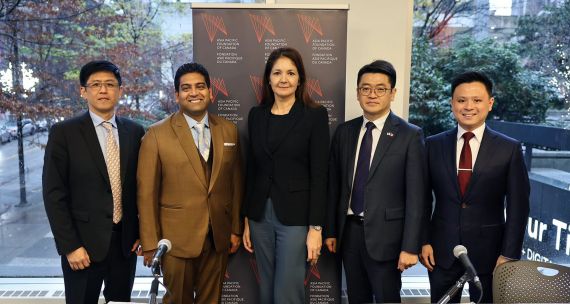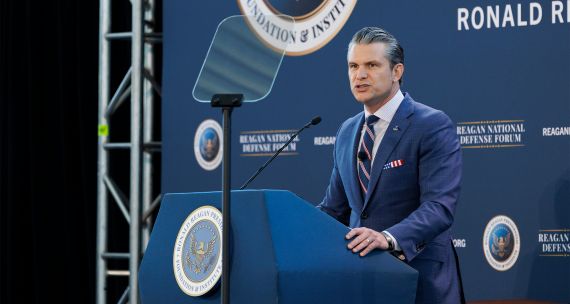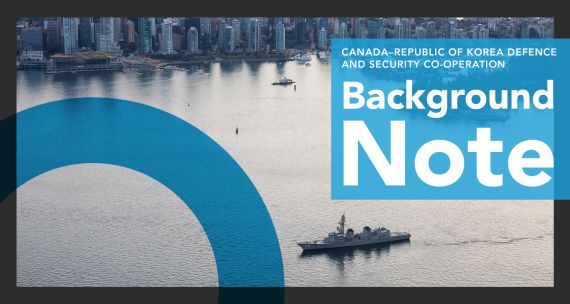On September 11, 2025, the Asia Pacific Foundation of Canada, in partnership with the Taiwan Economic and Cultural Office (TECO) in Canada, the Embassy of Lithuania, and the Embassy of Federal Republic of Germany in Ottawa, convened a roundtable on Democratic Resilience and Maritime Security: Protecting Undersea Cables and Digital Infrastructure. The event in Ottawa brought together ambassadors, policymakers, defence experts, industry representatives, and civil society leaders to examine one of the most pressing but often overlooked vulnerabilities of our interconnected world: the protection of undersea cables and critical digital infrastructure.
Although subsea cables carry 95 per cent of global digital traffic, including trillions of dollars in financial transactions and sensitive government communications, they remain vulnerable to natural disasters and sabotage and deliberate hybrid warfare tactics. As APF Canada Vice-President Research & Strategy Vina Nadjibulla noted, these infrastructures, which were “out of sight, out of mind” only a few years ago, have now emerged as frontline assets in the struggle to safeguard democratic resilience.
This report summarizes the highlights from the discussion.
Why Undersea Cables Matter
In her introduction, Nadjibulla emphasized that undersea cables — the digital arteries of the modern economy — have become both indispensable and highly vulnerable. Not only do they support daily communications, but they also underpin US$10 trillion in daily financial transactions, military operations, and government services. The cables’ concentrated importance and susceptibility to sabotage in critical chokepoints such as the Baltic Sea, the Taiwan Strait, and the South China Sea make them attractive targets for adversarial states and non-state actors alike.
She underscored three themes to frame the discussion:
1. Public–Private Partnerships: With the majority of infrastructure privately owned, governments alone cannot secure it.
2. Democratic Solidarity: Democracies must co-ordinate to respond to hybrid threats, especially given evidence of Russia–China co-operation in the maritime domain.
3. Canada’s ‘Bridging’ Role: Positioned between the Euro-Atlantic and the Indo-Pacific, Canada is uniquely placed to foster transregional dialogue and action.
Baltic Sea Vulnerabilities
Lithuanian Ambassador Egidijus Meilūnas offered a sobering assessment of the Baltic Sea region, which has been the target of Russian aggression. He noted that the Baltic Sea is shallow — on average, just 54 metres deep — making cables far more accessible to sabotage than in the Atlantic Ocean, where depths exceed 6,000 metres. At the same time, it is among the world’s busiest maritime routes, with 4,000 ships transiting daily, intensifying the risk of both accidents and deliberate interference.
Ambassador Meilūnas detailed four major sabotage incidents between late 2023 and 2024, including the Baltic connector pipeline rupture and the severing of multiple data cables linking Finland, Estonia, and Sweden. In several cases, Chinese-flagged vessels such as the NewNew Polar Bear and Russian “shadow fleet” cargo ships were present at the sites of damage. Though investigations into attribution remain inconclusive, he said the patterns clearly indicate state-linked hybrid operations.
Lithuania has responded with measures at three levels:
1. National: New legislation criminalizing sabotage and codifying rapid response protocols through its National Crisis Management Centre.
2. Regional: Enhanced cooperation via the Baltic Sea States Council (from which Russia was expelled after its invasion of Ukraine in 2022).
3. International: Participation in NATO’s Critical Undersea Infrastructure Network and the establishment of a NATO Maritime Centre dedicated to cable security.
Ambassador Meilūnas concluded by stressing two clear imperatives: democracies must draw red lines to deter aggressors, and they must increase support for Ukraine, which he described as “fighting not only for itself, but for the security of all Europe.” He added that the trans-Atlantic security was closely intertwined with that of the Indo-Pacific — hence also calling for enhancing support for Taiwan.
The Taiwan Strait Under Siege
Dr. Harry Tseng, Representative of TECO, shifted the focus to the Indo-Pacific, where Taiwan’s reliance on undersea cables is uniquely existential. With 24 cables (14 international, 10 domestic) carrying 99 per cent of its bandwidth, Taiwan would face catastrophic disruption if these cables were severed. One study estimates that the daily economic loss would be US$3.1 billion if all international links were disabled.
Dr. Tseng detailed several recent sabotage attempts by “flags of convenience” vessels — that is, ships registered in weak jurisdictions but linked to Chinese entities. Examples included:
- The Xing Shun 39, suspected of damaging the Taiwan–U.S. Trans-Pacific Express cable after loitering in Taiwanese waters with its automatic identification system tracking disabled.
- The Bao Shun, a Mongolian-registered vessel repeatedly circling Taiwan’s cable zones despite warnings from Taiwan’s coast guard.
- The Hong Tai 58, flagged in Togo, which deliberately dragged its anchor across a cable route, leading to Taiwan’s first-ever successful prosecution of cable sabotage. The captain was sentenced to three years in prison.
Dr. Tseng also emphasized that such activities form part of China’s grey-zone tactics, aiming to test international tolerance and gradually normalize coercive behaviour without triggering outright war. He outlined Taiwan’s countermeasures:
1. Active monitoring: Blacklisting 96 suspicious vessels, supported by unmanned aerial vehicles and unmanned surface vehicles for surveillance.
2. Integrated response: Strengthened navy-coast guard co-ordination and rapid reporting systems linking prosecutors and law enforcement.
3. Resilience-building: Investments in low-earth orbit satellites to diversify connectivity.
4. International co-operation: Collaboration with democratic allies in detecting dark vessels near Taiwan’s waters.
“Attacks on cables in Taiwan and the Baltic may seem distant,” Tseng warned, “but what happens undersea today could threaten all democracies tomorrow.”
Building Legal and Technological Defences
German Deputy Ambassador Karina Häuslmeier framed the issue within Europe’s wider security environment, where Russia’s war in Ukraine and drone incursions into Poland underscore the blurred line between war and peace. “We are not at war,” she noted, “but we are certainly not at peace.”
Germany, she explained, has just passed new critical infrastructure legislation mandating that operators develop resilience plans against sabotage, implementing the EU’s Critical Entities Resilience Directive. At the European level, the 2024 EU Action Plan for Subsea Cables focuses on prevention, detection, response, and deterrence, with major investments in cybersecurity and maritime monitoring.
Häuslmeier highlighted the importance of the Baltic Sea Summit in Helsinki at the NATO level and the alliance’s expanded maritime presence. NATO now deploys underwater drones, artificial intelligence, and situational awareness tools to proactively prevent sabotage. Germany is also engaged in bilateral and G7 initiatives, including the 2025 G7 Declaration on Maritime Security and Prosperity.
Häuslmeier acknowledged that despite progress, challenges remain, including jurisdictional gaps between civilian, military, and intelligence authorities; difficulties in information-sharing; and the need to better integrate private sector operators. Nonetheless, she reaffirmed Germany’s commitment to advancing resilience through innovation and allied co-operation.
Themes and Takeaways
In the moderated discussion, one participant emphasized the importance of attribution. Without clear evidence linking sabotage to state actors, deterrence and response options remain limited. The participant posed a pointed question: Are China’s cable disruptions “reconnaissance or rehearsal” for larger operations, such as a blockade or invasion of Taiwan? Another participant highlighted the UK’s use of its 2023 National Security Act to prosecute hybrid attacks, including a Russian-directed arson attack in London. They suggested that sharing legislative innovations could strengthen collective deterrence against state-sponsored sabotage. There was also a comment that underscored the need for closer public–private collaboration, as cable operators and energy companies often detect incidents before governments do. However, the challenges in information-sharing and liability frameworks were also noted.
Several other cross-cutting themes emerged from the discussion:
1. Hybrid warfare as a psychological weapon
Beyond its physical impact, the sabotage of subsea cables seeks to sow insecurity, undermine trust in institutions, and demonstrate the vulnerability of democracies.
2. Attribution and accountability
Difficulty in attributing sabotage hampers deterrence. Participants stressed the need for clearer evidentiary standards, joint investigations, and political will to assign blame.
3. Legal innovation
From Lithuania’s criminalization of sabotage to Germany’s infrastructure law and Taiwan’s landmark prosecution, legislative adaptation is becoming a frontline defence.
4. Public–Private partnerships
With most cables are privately owned, governments must incentivize cooperation, invest in redundancy, and engage industry in joint planning and exercises.
5. Transregional linkages
Security in the Euro-Atlantic and Indo-Pacific is intertwined. Russia and China co-ordinate their strategies; democracies must do the same. Canada, bridging both regions, has a unique role to play.
6. Technology and innovation
Surveillance tools such as AI-enabled monitoring, UAVs, and dark vessel detection offer cost-effective ways to strengthen maritime domain awareness.
The roundtable underscored that undersea cables are the digital lifelines of democracies. Their protection is not a niche technical issue but a central pillar of national security, economic stability, and democratic resilience. It connects a number of issues, and Canada is a strategic actor that is simultaneously an Indo-Pacific, Atlantic, and Arctic actor.
The speakers from Lithuania, Taiwan, and Germany highlighted how authoritarian states increasingly target this infrastructure to destabilize democracies, test international resolve, and advance their strategic aims. Canada and its allies must respond with a combination of legal innovation, technological investment, international co-operation, and above all, solidarity.
As Dr. Tseng noted in his concluding remarks, “Cutting communications is a form of hybrid warfare. While short of a full-scale war, it can be a compelling prelude to one.” The more democracies prepare together, the less vulnerable they will be to such coercive tactics. This roundtable, bridging the Euro-Atlantic and Indo-Pacific, was a critical step toward that collective preparedness.
• Edited by Erin Williams, Director, Programs, and Ted Fraser, Senior Editor, APF Canada





